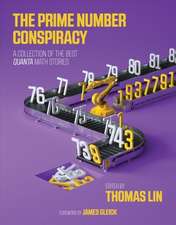Faster: The Acceleration of Just about Everything
Autor James Gleicken Limba Engleză Paperback – 31 aug 2000
Vezi toate premiile Carte premiată
Audies (2000)
Most of us suffer some degree of "hurry sickness." a malady that has launched us into the "epoch of the nanosecond," a need-everything-yesterday sphere dominated by cell phones, computers, faxes, and remote controls. Yet for all the hours, minutes, and even seconds being saved, we're still filling our days to the point that we have no time for such basic human activities as eating, sex, and relating to our families. Written with fresh insight and thorough research, Faster is a wise and witty look at a harried world not likely to slow down anytime soon.
Preț: 117.69 lei
Nou
Puncte Express: 177
Preț estimativ în valută:
22.52€ • 23.51$ • 18.64£
22.52€ • 23.51$ • 18.64£
Carte disponibilă
Livrare economică 14-28 martie
Preluare comenzi: 021 569.72.76
Specificații
ISBN-13: 9780679775485
ISBN-10: 067977548X
Pagini: 352
Ilustrații: 5 LINE DRAWINGS IN TEXT
Dimensiuni: 132 x 201 x 20 mm
Greutate: 0.36 kg
Ediția:Vintage Books.
Editura: Vintage Books USA
ISBN-10: 067977548X
Pagini: 352
Ilustrații: 5 LINE DRAWINGS IN TEXT
Dimensiuni: 132 x 201 x 20 mm
Greutate: 0.36 kg
Ediția:Vintage Books.
Editura: Vintage Books USA
Notă biografică
James Gleick (www.around.com) was born in New York City in 1954. He worked for ten years as an editor and reporter for The New York Times, founded an early Internet portal, the Pipeline, and wrote three previous books: Chaos, Genius, and Faster. His latest book Isaac Newton is available from Pantheon. He lives in the Hudson Valley of New York with his wife.
Extras
You are in the Directorate of Time. Naturally you are running late. You hurry past a glass-paned vault in which the world's number-one clock is soundlessly assembling each second from nine billion parts. It looks more like a rack of computers than a clock. In its core, atoms of cesium vibrate with a goose-stepping pace so sure, so authoritative, so humbling--but your mind wanders. There is not a moment to lose. Striding onward, you reach the office of the director of the Directorate of Time. He is a craggy, white-haired man called Gernot M. R. Winkler. He glances across the desk and says, "We have to be fast."
The directorate, an agency of the United States military, has scattered dozens of atomic clocks across a calm, manicured hilltop near the Potomac River in Washington. Armed guards stand watch at a security gatehouse down below, mainly because the Vice President's residence occupies the same grounds. Once past their scrutiny you can walk alone up the long drive to the stately 150-year-old Naval Observatory, the first national observatory of the United States. Long ago a four-foot ball of Charles Goodyear's Gumelastic rubber hung from a mast atop the observatory dome and dropped daily at noon to signal the time. Now the signals come more quickly. The Master Clock consults with fifty others in separate climate-controlled vaults--cesium clocks and hydrogen masers powered by diesel generators and backup batteries. They check off the seconds as an ensemble and communicate continuously via fiber-optic cable with counterparts overseas. The clocks monitor one another, and individual devices can come on or off line as their performance warrants. Out-of-sync clocks reveal themselves quickly. Winkler offers an analogy: "It's like a court of law, where you have many slightly different stories and one wildly different story." When the plausible witnesses are chosen and assembled, their output is statistically merged, worldwide, at the Bureau International des Poids et Mesures, outside Paris. The American contribution is the largest.
The result is the exact time. The exact time--by definition, by worldwide consensus and decree. The timekeepers at the directorate like to quote the old saw (Winkler quotes it now): "A man with a watch knows what time it is. A man with two watches is never sure." Humanity is now a species with one watch, and this is it.
Through most of history, time was fixed by astronomical reference points--the Earth spins once, call it a day. No more. The absolute reference has shifted from the stars to the atomic beams in their vaults. Particles are steadier than planets. Never mind the uncertainty principle; it is the heavens that cannot be relied on. Stars drift. The Earth shivers ever so slightly. With the oceanic tides acting as brakes, the planet slows in its rotation by fractions of a second each year. These anomalies do matter, in a time-gripped age. To compensate, the official clocks must every so often perform a grudging two-step, adding an odd second--a "leap second"--to the world's calendar. Most often, leap seconds are inserted at the close of December 31. The New Year clicks in sneakily: 11:59:58 p.m., 11:59:59, 11:59:60 (!), 12:00:00 a.m., 12:00:01. The descendant of the Naval Observatory's old Gumelastic rubber ball drops, studded with light bulbs, in Times Square. Elsewhere, astronomical observatories, television networks, and time-obsessed computer users make an adjustment to catch the leap second. Observatories have been known to get the sign wrong, ruining a night's sky-watching with the difference between +1 second and -1. As the Earth continues to slow, leap seconds will grow more common. Eventually we will need one every year, and then even more. Scientists could have avoided these awkward skips by choosing instead to adjust the duration of the second itself. Who would notice? That is what they did, in fact, until 1955. They defined the second as 1/86,400 of a real day, however long that was. The second had to lengthen a tiny bit each year. The atomic clocks were retuned as necessary. This did not trouble most of us, even subliminally, but it did start to annoy atomic physicists, because they needed a temporal measuring stick that would not stretch: come on, a second is a second--give me a real SECOND.
So here is the real second. Here the technologies of speed reach the ultimate. "Fifty years ago," Winkler says wistfully--he was a schoolboy in Austria--"we made measurements of a tenth of a second from day to day. That was great. Then more and more applications came in with greater refinements. It is like anywhere in life. When you have a capability, people find a use for that.
"Submarines have to surface for communications--they have atomic clocks," Winkler continues. "Television transmitters have atomic clocks. If you have two transmitters on the same channel, and you are between two cities, the picture will go up and down unless they are on exactly the same frequency. All good television stations have a rubidium clock." You are briefly aware of something incongruous about this exactitude--but the hyperprecision is all too familiar, all too closely in step with the rhythms of your more ordinary haunts.
We have reached the epoch of the nanosecond. This is the heyday of speed. "Speed is the form of ecstasy the technical revolution has bestowed on man," laments the Czech novelist Milan Kundera, suggesting by ecstasy a state of simultaneous freedom and imprisonment ("He is caught in a fragment of time cut off from both the past and the future; he is wrenched from the continuity of time; he is outside time . . ."). That is our condition, a culmination of millennia of evolution in human societies, technologies, and habits of mind.
The finicality of the modern timekeepers departs even further from our everyday experience--a fact cheerfully acknowledged here at the directorate. Particle physicists may freeze a second, open it up, and explore its dappled contents like surgeons pawing through an abdomen, but in real life, when events occur within thousandths of a second, our minds cannot distinguish past from future. What can we grasp in a nanosecond--a billionth of a second? "I tell you," Winkler says, "it wasn't on a human scale when we were measuring time to a millisecond, and now we are down to a fraction of a nanosecond." Within the millisecond, the bat presses against the ball; a bullet finds time to enter a skull and exit again; a rock plunges into a still pond, where the unexpected geometry of the splash pattern pops into existence. During a nanosecond, balls, bullets, and droplets are motionless.
Inhuman though these compressed time scales may be, many humans crave the precision. Internet users set their computers to update their clocks according to the directorate's time signal. The directorate fields millions of automatic queries each day. By pinging back and forth across the network, software called NanoSecond or RightTime or Clockwork or TimeSync or Timeset
can correct for propagation delays along the phone lines between the atomic clocks and you. Free connections can be made to modems or to "time servers" with the whimsical pair of addresses, tick.usno.navy.mil and tock.usno.navy.mil. More crudely, anyone with a telephone can dial the Naval Observatory's Master Clock Voice Announcer, for fifty cents the first minute. The time-obsessed used to keep their watches accurate to within seconds; now they keep their computers accurate to within milliseconds.
Nanosecond precision matters for worldwide communications systems. It matters for navigation by Global Positioning System satellite signals: an error of a billionth of a second means an error of just about a foot, the distance light travels in that time. One nanosecond--one foot. That is a modern equivalence worth memorizing. Cellular phone networks and broadcasters' transmitters need fine timing to squeeze more and more channels of communication into precisely tuned bandwidth. The military, especially, finds ways to use superprecise timing. It is no accident that the Directorate of Time belongs to the Department of Defense. Knowing the exact time is an essential feature of delivering airborne explosives to exact locations--individual buildings, or parts of buildings--thus minimizing one of the department's standard euphemisms, collateral damage.
Few institutions are so intensely focused on so pure a goal. Keeping the right time brings together an assortment of technologies and sciences. The directorate's astronomers study the most distant quasars--admiring them for their apparent fixedness in the sky. A favored set of 462 quasars provides as rigid a frame as can be found. Meanwhile, the directorate has a team of earth scientists to study the slowing rotation and the occasional wobble--a problem that comes down to watching the weather, because the planet's spin varies each year with the wind blowing on mountains. In all, the scientists who control the clocks have achieved a surpassing precision. As the eighteenth century mastered the measurement of mass, and the nineteenth, with the establishment of international geodesy, conquered the measurement of distance, the even ghostlier quantity, time, had to wait for the technologies of the twentieth century.
The seconds pass here with a consistency that no pair of scales or rulers can match. The worst distortion that can accumulate, each day, remains proportionately smaller than a hairsbreadth in the distance from the Earth to the Sun--the equivalent of one second in a million years. "This is extremely important," Winkler says, the accent of his native Austria breaking through. His hand slashes through the air like an ax. "We want to be exact."
So synchronize your watches. Here are the pacemakers, the merchants of exactitude, the owners of the pulse in the global circulatory system. When the Lilliputians first saw Gulliver's watch, that "wonderful kind of engine . . . a globe, half silver and half of some transparent metal," they identified it immediately as the god he worshipped. After all, "he seldom did anything without consulting it: he called it his oracle, and said it pointed out the time for every action of his life." To Jonathan Swift in 1726 that was worth a bit of satire. Modernity was under way. We're all Gullivers now.
Or are we Yahoos?
Your eyes wander toward Winkler's wrist--what sort of watch would satisfy the director of the Directorate of Time?--but you cannot quite see it, as he asks: "Can you miss a plane by a millisecond? Of course not."
He pauses and adds with pride, "I missed one by five seconds once."
It has been noted by psychologists and airline managers alike that some people prefer to arrive at airports in plenty of time, keeping time to spare, so that they can have time on their hands in the lounge or kill time in the bar. Others cannot be happy unless they time their arrival so closely that, having dashed the last fifty yards to the gate, they race up the ramp, flash their boarding pass at the flight attendant, and slip into their seat with the thunk of the aircraft door fresh in their ears. Not a moment wasted. Perhaps these dashers, always flirting with lateness, are the victims of what some doctors and sociologists have named "hurry sickness." Then again, perhaps it is the seemingly calm, secretly obsessive early arrivers who suffer hurry sickness more.
Both types must be seeking peace of mind. One type can relax in the waiting lounge or even the check-in line, having minimized the risk of missing a flight. The other can hope to rest assured that they have minimized a different quantity: wasted time. Airport gates are not the only places where people like to flirt with lateness. But in their way they serve as focal points in the modern world, places where the technology and the psychology of hurriedness come together. Airport gates are where we contemplate the miraculous high speeds of air transport and the unmiraculous speeds associated with getting to air transport. One measure of twentieth-century time is the supersonic three and three-quarter hours it takes the Concorde to fly from New York to Paris, gate to gate. Other measures come with the waits on the expressways and the runways. Gridlocked and tarmacked are metonyms of our era: to be gridlocked or tarmacked is to be stuck in place, our fastest engines idling all around, as time passes and blood pressures rise.
The directorate, an agency of the United States military, has scattered dozens of atomic clocks across a calm, manicured hilltop near the Potomac River in Washington. Armed guards stand watch at a security gatehouse down below, mainly because the Vice President's residence occupies the same grounds. Once past their scrutiny you can walk alone up the long drive to the stately 150-year-old Naval Observatory, the first national observatory of the United States. Long ago a four-foot ball of Charles Goodyear's Gumelastic rubber hung from a mast atop the observatory dome and dropped daily at noon to signal the time. Now the signals come more quickly. The Master Clock consults with fifty others in separate climate-controlled vaults--cesium clocks and hydrogen masers powered by diesel generators and backup batteries. They check off the seconds as an ensemble and communicate continuously via fiber-optic cable with counterparts overseas. The clocks monitor one another, and individual devices can come on or off line as their performance warrants. Out-of-sync clocks reveal themselves quickly. Winkler offers an analogy: "It's like a court of law, where you have many slightly different stories and one wildly different story." When the plausible witnesses are chosen and assembled, their output is statistically merged, worldwide, at the Bureau International des Poids et Mesures, outside Paris. The American contribution is the largest.
The result is the exact time. The exact time--by definition, by worldwide consensus and decree. The timekeepers at the directorate like to quote the old saw (Winkler quotes it now): "A man with a watch knows what time it is. A man with two watches is never sure." Humanity is now a species with one watch, and this is it.
Through most of history, time was fixed by astronomical reference points--the Earth spins once, call it a day. No more. The absolute reference has shifted from the stars to the atomic beams in their vaults. Particles are steadier than planets. Never mind the uncertainty principle; it is the heavens that cannot be relied on. Stars drift. The Earth shivers ever so slightly. With the oceanic tides acting as brakes, the planet slows in its rotation by fractions of a second each year. These anomalies do matter, in a time-gripped age. To compensate, the official clocks must every so often perform a grudging two-step, adding an odd second--a "leap second"--to the world's calendar. Most often, leap seconds are inserted at the close of December 31. The New Year clicks in sneakily: 11:59:58 p.m., 11:59:59, 11:59:60 (!), 12:00:00 a.m., 12:00:01. The descendant of the Naval Observatory's old Gumelastic rubber ball drops, studded with light bulbs, in Times Square. Elsewhere, astronomical observatories, television networks, and time-obsessed computer users make an adjustment to catch the leap second. Observatories have been known to get the sign wrong, ruining a night's sky-watching with the difference between +1 second and -1. As the Earth continues to slow, leap seconds will grow more common. Eventually we will need one every year, and then even more. Scientists could have avoided these awkward skips by choosing instead to adjust the duration of the second itself. Who would notice? That is what they did, in fact, until 1955. They defined the second as 1/86,400 of a real day, however long that was. The second had to lengthen a tiny bit each year. The atomic clocks were retuned as necessary. This did not trouble most of us, even subliminally, but it did start to annoy atomic physicists, because they needed a temporal measuring stick that would not stretch: come on, a second is a second--give me a real SECOND.
So here is the real second. Here the technologies of speed reach the ultimate. "Fifty years ago," Winkler says wistfully--he was a schoolboy in Austria--"we made measurements of a tenth of a second from day to day. That was great. Then more and more applications came in with greater refinements. It is like anywhere in life. When you have a capability, people find a use for that.
"Submarines have to surface for communications--they have atomic clocks," Winkler continues. "Television transmitters have atomic clocks. If you have two transmitters on the same channel, and you are between two cities, the picture will go up and down unless they are on exactly the same frequency. All good television stations have a rubidium clock." You are briefly aware of something incongruous about this exactitude--but the hyperprecision is all too familiar, all too closely in step with the rhythms of your more ordinary haunts.
We have reached the epoch of the nanosecond. This is the heyday of speed. "Speed is the form of ecstasy the technical revolution has bestowed on man," laments the Czech novelist Milan Kundera, suggesting by ecstasy a state of simultaneous freedom and imprisonment ("He is caught in a fragment of time cut off from both the past and the future; he is wrenched from the continuity of time; he is outside time . . ."). That is our condition, a culmination of millennia of evolution in human societies, technologies, and habits of mind.
The finicality of the modern timekeepers departs even further from our everyday experience--a fact cheerfully acknowledged here at the directorate. Particle physicists may freeze a second, open it up, and explore its dappled contents like surgeons pawing through an abdomen, but in real life, when events occur within thousandths of a second, our minds cannot distinguish past from future. What can we grasp in a nanosecond--a billionth of a second? "I tell you," Winkler says, "it wasn't on a human scale when we were measuring time to a millisecond, and now we are down to a fraction of a nanosecond." Within the millisecond, the bat presses against the ball; a bullet finds time to enter a skull and exit again; a rock plunges into a still pond, where the unexpected geometry of the splash pattern pops into existence. During a nanosecond, balls, bullets, and droplets are motionless.
Inhuman though these compressed time scales may be, many humans crave the precision. Internet users set their computers to update their clocks according to the directorate's time signal. The directorate fields millions of automatic queries each day. By pinging back and forth across the network, software called NanoSecond or RightTime or Clockwork or TimeSync or Timeset
can correct for propagation delays along the phone lines between the atomic clocks and you. Free connections can be made to modems or to "time servers" with the whimsical pair of addresses, tick.usno.navy.mil and tock.usno.navy.mil. More crudely, anyone with a telephone can dial the Naval Observatory's Master Clock Voice Announcer, for fifty cents the first minute. The time-obsessed used to keep their watches accurate to within seconds; now they keep their computers accurate to within milliseconds.
Nanosecond precision matters for worldwide communications systems. It matters for navigation by Global Positioning System satellite signals: an error of a billionth of a second means an error of just about a foot, the distance light travels in that time. One nanosecond--one foot. That is a modern equivalence worth memorizing. Cellular phone networks and broadcasters' transmitters need fine timing to squeeze more and more channels of communication into precisely tuned bandwidth. The military, especially, finds ways to use superprecise timing. It is no accident that the Directorate of Time belongs to the Department of Defense. Knowing the exact time is an essential feature of delivering airborne explosives to exact locations--individual buildings, or parts of buildings--thus minimizing one of the department's standard euphemisms, collateral damage.
Few institutions are so intensely focused on so pure a goal. Keeping the right time brings together an assortment of technologies and sciences. The directorate's astronomers study the most distant quasars--admiring them for their apparent fixedness in the sky. A favored set of 462 quasars provides as rigid a frame as can be found. Meanwhile, the directorate has a team of earth scientists to study the slowing rotation and the occasional wobble--a problem that comes down to watching the weather, because the planet's spin varies each year with the wind blowing on mountains. In all, the scientists who control the clocks have achieved a surpassing precision. As the eighteenth century mastered the measurement of mass, and the nineteenth, with the establishment of international geodesy, conquered the measurement of distance, the even ghostlier quantity, time, had to wait for the technologies of the twentieth century.
The seconds pass here with a consistency that no pair of scales or rulers can match. The worst distortion that can accumulate, each day, remains proportionately smaller than a hairsbreadth in the distance from the Earth to the Sun--the equivalent of one second in a million years. "This is extremely important," Winkler says, the accent of his native Austria breaking through. His hand slashes through the air like an ax. "We want to be exact."
So synchronize your watches. Here are the pacemakers, the merchants of exactitude, the owners of the pulse in the global circulatory system. When the Lilliputians first saw Gulliver's watch, that "wonderful kind of engine . . . a globe, half silver and half of some transparent metal," they identified it immediately as the god he worshipped. After all, "he seldom did anything without consulting it: he called it his oracle, and said it pointed out the time for every action of his life." To Jonathan Swift in 1726 that was worth a bit of satire. Modernity was under way. We're all Gullivers now.
Or are we Yahoos?
Your eyes wander toward Winkler's wrist--what sort of watch would satisfy the director of the Directorate of Time?--but you cannot quite see it, as he asks: "Can you miss a plane by a millisecond? Of course not."
He pauses and adds with pride, "I missed one by five seconds once."
It has been noted by psychologists and airline managers alike that some people prefer to arrive at airports in plenty of time, keeping time to spare, so that they can have time on their hands in the lounge or kill time in the bar. Others cannot be happy unless they time their arrival so closely that, having dashed the last fifty yards to the gate, they race up the ramp, flash their boarding pass at the flight attendant, and slip into their seat with the thunk of the aircraft door fresh in their ears. Not a moment wasted. Perhaps these dashers, always flirting with lateness, are the victims of what some doctors and sociologists have named "hurry sickness." Then again, perhaps it is the seemingly calm, secretly obsessive early arrivers who suffer hurry sickness more.
Both types must be seeking peace of mind. One type can relax in the waiting lounge or even the check-in line, having minimized the risk of missing a flight. The other can hope to rest assured that they have minimized a different quantity: wasted time. Airport gates are not the only places where people like to flirt with lateness. But in their way they serve as focal points in the modern world, places where the technology and the psychology of hurriedness come together. Airport gates are where we contemplate the miraculous high speeds of air transport and the unmiraculous speeds associated with getting to air transport. One measure of twentieth-century time is the supersonic three and three-quarter hours it takes the Concorde to fly from New York to Paris, gate to gate. Other measures come with the waits on the expressways and the runways. Gridlocked and tarmacked are metonyms of our era: to be gridlocked or tarmacked is to be stuck in place, our fastest engines idling all around, as time passes and blood pressures rise.
Recenzii
"Fascinating and disturbing, amusing and informative, Faster is an eclectic stew combining history, academic research, and anecdotes drawn from the popular media." --The Boston Globe
"Well written and enjoyable. . . . A book that demands your attention." --The Christian Science Monitor
"Nimble, smart, often funny, and--best of all--fast." --The New York Times Book Review
"Well written and enjoyable. . . . A book that demands your attention." --The Christian Science Monitor
"Nimble, smart, often funny, and--best of all--fast." --The New York Times Book Review
Descriere
Gleick examines the phenomenon of "hurry sickness" that has taken hold of today's society through cell phones, computers, faxes and remote controls. Illustrations.
Premii
- Audies Nominee, 2000

















